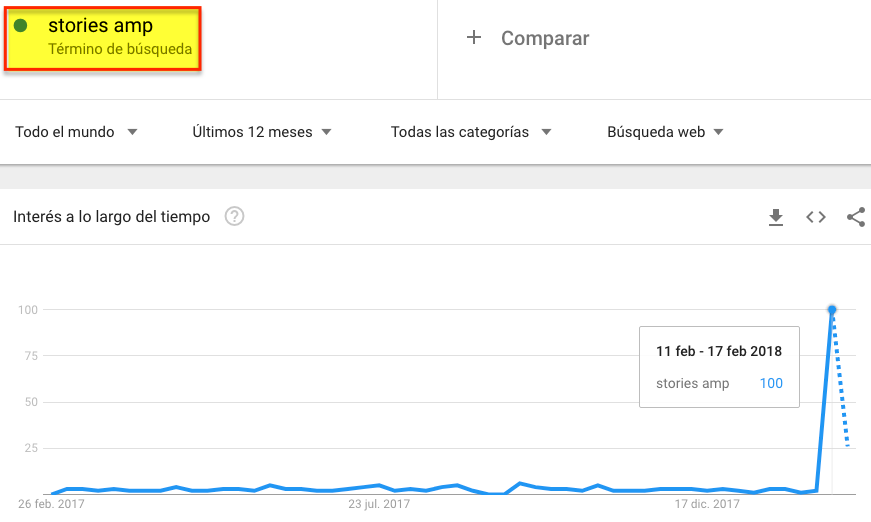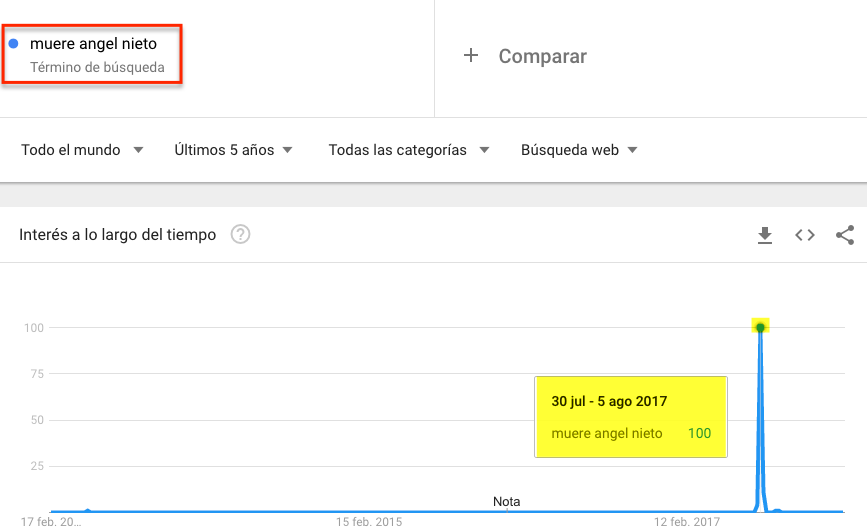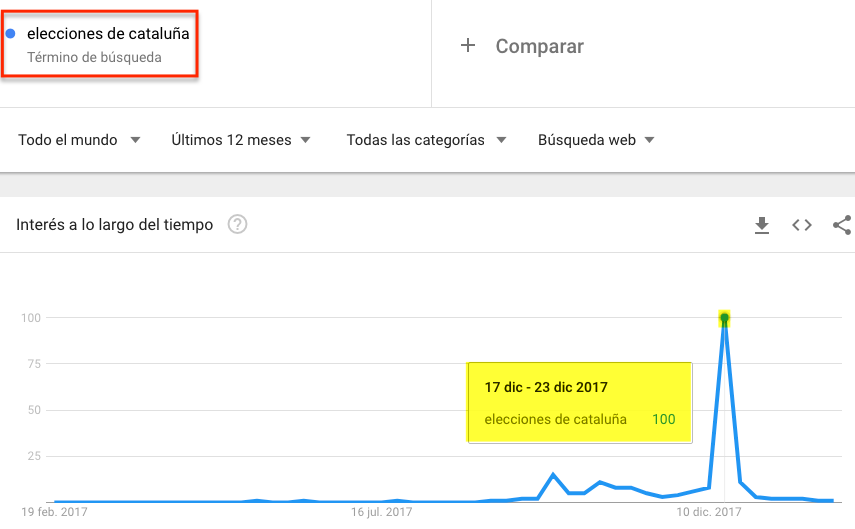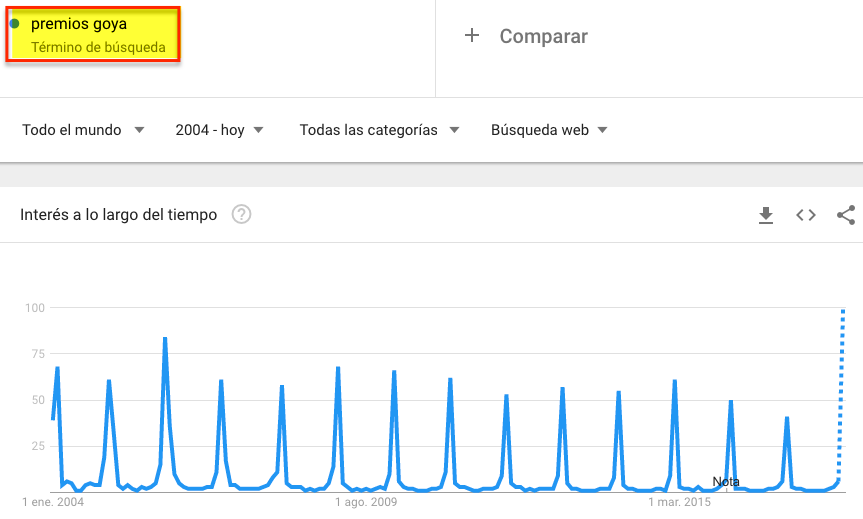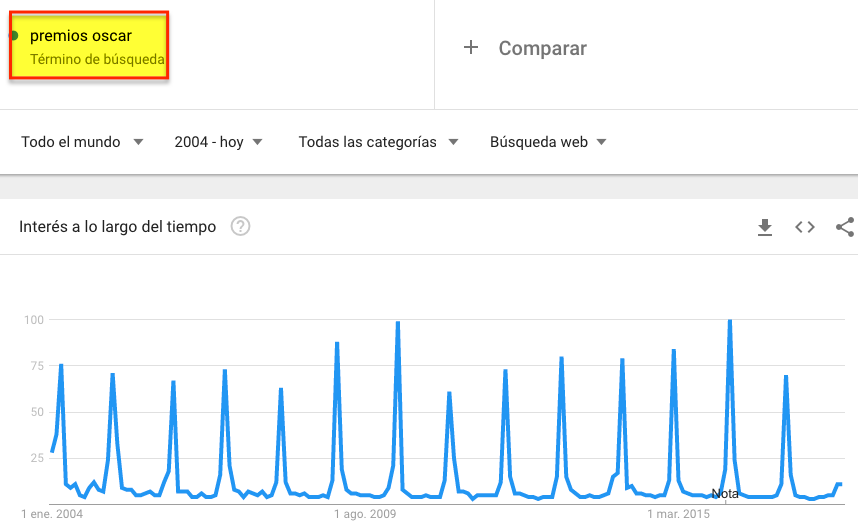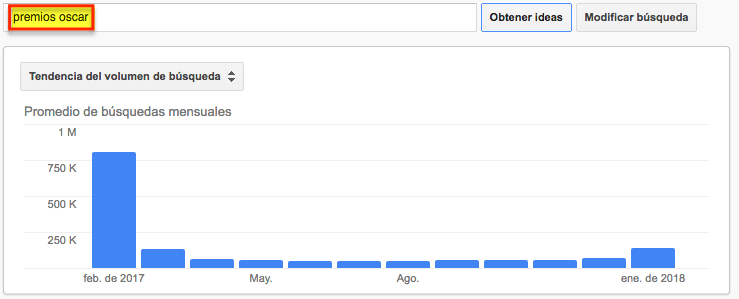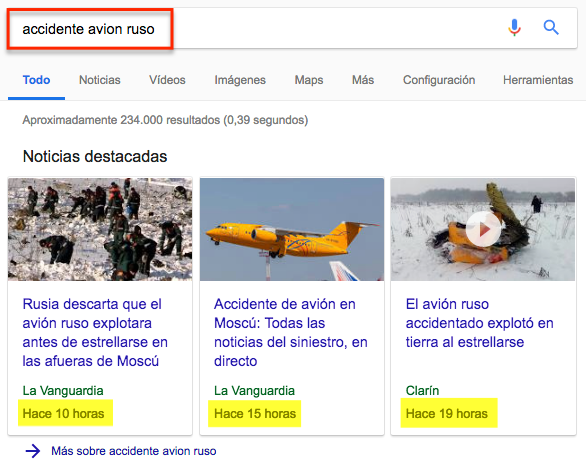Written by Rocío Rodríguez
Index
- What are topical searches
- Types of topical content
- How can topical searches influence my ranking?
- How to detect, generate and optimize topical content
- How to track the positioning of recurring and predictable topical searches
- Common mistakes in the generation of topical content that can negatively influence your positioning
Although the term “news search” takes us directly to news websites such as El Pais or As, this type of search can also help us to improve the positioning of other sites such as blogs of online stores or corporate websites such as banks or online marketing agencies.
If we pay attention to the following two images we can see how the term “stories amp” becomes trending topic for several days in February 2018:
Many marketing consultancies, agencies and blogs are echoing the news and publishing it on their respective websites:
This scenario is perfectly applicable to any news item in any other sector: banking, finance, pharmaceuticals, etc.
What are topical searches
In media positioning , when we talk about current searches, we refer to those that reach their highest peak of searches at specific moments in time:
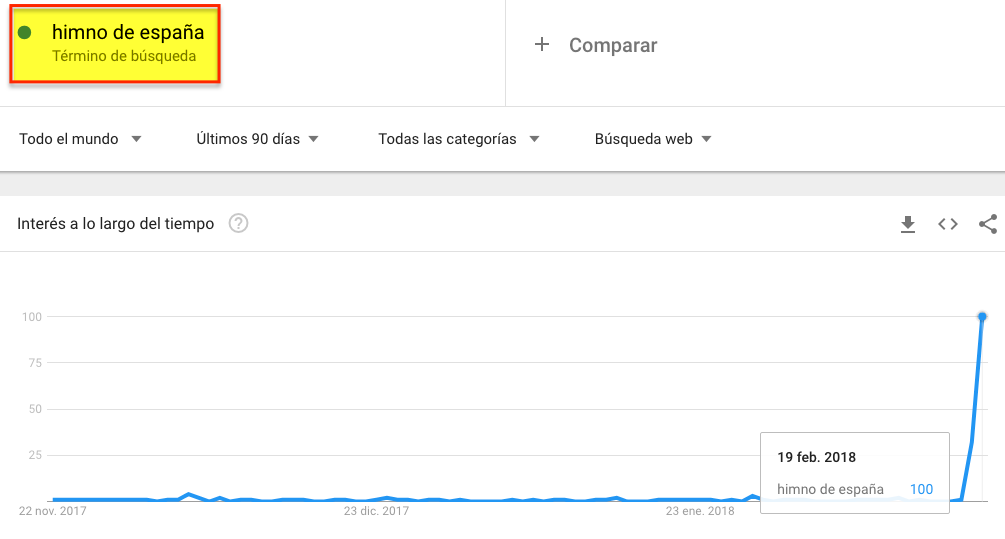
In order to know the global positioning of a given online media, it is important that we do not stick to a sample of static keywords. A variable sample should also be monitored. In this group we will consider the inclusion of current search terms, as these also have a significant weight in the positioning of the site, giving it visibility and traffic.
Current searches have a significant impact on the visibility and traffic of the site and should therefore be taken into account in the overall evaluation of the positioning of the medium.
Types of topical content
We can find different types of topical content:
Breaking News
These are news items that arise unexpectedly in response to unforeseeable events or occurrences. For example, the death of a public figure of great national recognition:
Predictable events
These are current news items that we can foresee, even if they do not occur from one year to the next. For example, the elections in Catalonia or the launch of a particular car model.
As can be seen in the graph, peak traffic occurs punctually on one or more specific days:
Recurring events
We can also foresee these events. These are events that occur throughout the years on similar dates.. For example, the Goya Awards Gala or the Detroit Auto Show. The predictable nature of this type of search allows us to generate and position content about it just at the moment when searches on that particular topic reach their peak.
If we analyze the trends over several years, we can see how the peak of searches occurs regularly at a certain time each year:
How can topical searches influence my ranking?
Current news can help us attract a high percentage of organic traffic to the site as searches for a particular term increase considerably at specific times over time. However, it is not enough just to generate the piece and wait for Google to crawl and index it so that it can be returned as a search result. In this case it is advisable to work on the optimization of the news item, paying attention to on page SEO factors such as hierarchy titles, ALT texts in images, linking of the news item, etc. In this way we will increase the chances of the piece acquiring sufficient visibility to be classified in visible positions in the ranking.
How to detect, generate and optimize topical content
Identify current searches
- In the case of searches generated by current affairs or Breaking News, we will not be able to identify them as they occur completely unexpectedly.
- As for predictable events, their detection can be complex since they do not occur at similar times throughout the year. For example, the wedding of a celebrity or the launch of a new car model. In this case, the media’s capacity to collect and publish this type of events that may arouse the reader’s interest will be of paramount importance.
- Recurring searches can be identified in two different ways: by using search trend analysis tools or by “pulling” from historical data and our knowledge of our industry. In the detection of this type of topical content, it can also help us to have the following available The company has developed an annual thematic calendar reflecting all the events or happenings that occur every year, in order to be able to monitor them as accurately as possible.
Tools to detect recurring topical issues
Google Trends is one of the tools that can help us during the detection of recurring terms, as it analyzes the search interest, over time, of the keyword or phrase on which we want to perform the analysis. All we have to do is include the term in the search box at the top left of the page. In the example below we can see the search trend for the keyword “oscar awards” over the last 13 years:
As can be seen in the image above, since 2008, the highest search volume occurs in February. When performing this analysis, it is advisable to extend the time period as much as possible, in order to have a much broader perspective of the progression followed by the term.
Through the Google tool, Keyword Planner we can also know the trend of searches for a specific term during the last twelve months. Although in this case we cannot make a comparison with months of previous years, it can serve as a guide and to contrast the data recorded by the Google Trends tool.:
Acting with immediacy
The peak audience for current news is limited (24-48h).
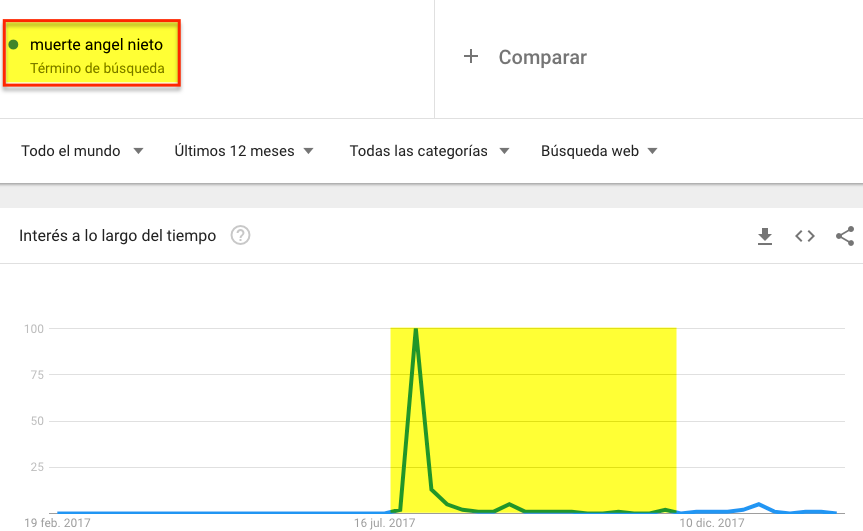
In terms of positioning, immediacy is one of the factors that influences the ranking, along with many others such as the thematic authority of the media, being those that publish more news on a given topic those that are better positioned.
Constant updating
Another metric that Google can take into account for the ranking of a news item is the update capacity of the piece.
The November 2011 Google Freshness algorithm update rewards content freshness. Likewise, this algorithm change has allowed for more current and accurate search results to be returned. In the case of recent events, if the crawler detects that a topic is being highly commented in the media, the probability that the user will receive current results with recent content is quite high.
As for the update frequency, there is no recommended minimum or maximum interval, however a higher update frequency will be a factor valued very positively by Google, as this will indicate that the media in question is up to date with the news and is following it correctly and accurately. We must understand the update of a news item as the inclusion of new content related to it and that will help to enrich and add value to it. The more content you change in the piece, the better.
Unique, original and valuable content
The writing of the piece must be original, without losing the essence of the news, so that it differs as much as possible from the news source. We must allude to all the details of the news that we know, provide reliable information and offer valuable content.
As long as the content of the news allows it, we should link to the background (both internal and external news, there must be a balance) so that the user has a broader chronological perspective of the news. A case of external linking would be, for example, a blog of an online pharmacy that publishes a news item about the growth of the pharmaceutical sector in the last year and links to the following news item from an online media:“Turnover in the pharmaceutical market in Spain in the last year“.
Links to other content related to the news item should also be included. These links should be included in the first paragraph while links to background information should be included in the rest of the paragraphs of the news item.
Internal interlinking
We must favor with greater popularity the pages that can be more profitable at any given moment, that is, those that respond to searches that have a higher traffic potential. Current news and the most searched or demanded articles at a specific time should concentrate a higher proportion of “popularity juice” through a strategic arrangement of internal and external interlinking. It is therefore advisable to link to these current contents from prominent places on the site when they are newsworthy. This internal linking strategy will allow us to give these pages a higher degree of relevance compared to the rest, which will favor them to be returned as results after a related search performed by the user.
The improvement in the structure of the page will allow us to improve the positioning for current searches that reach their peak of popularity at certain times.
An example of this type of linking can be seen in the digital newspaper La Vanguardia, where they are linking from a module located at the top of the main menu, the current news that are not older than 24h:

It is also important to take care of the wording of the anchor text. For SEO purposes, it is advisable that the anchor text chosen matches exactly the search performed by the user. This will increase the relevance of that page for relevant searches.
To find out how users search for a news item, we can use keyword suggestion tools such as Google Suggest or Google related searches.
Update title and description
The update of the piece should be accompanied by the update of the title and description. This will allow us to adapt these SEO fields to the user’s search intention, which will vary during the life of the news item. For example, news of a celebrity’s hospitalization could be accompanied by the following title: “[nombre del famoso] hospitalized […]”. However, as the hours go by, the user will be interested in knowing his state of health, his prognosis, etc., so we will have to adapt and modify the title taking into account this change in his search intention:
We will follow the same procedure with the metadescription. These changes will improve the relevance of the page for relevant searches.. In addition, the CTR should improve, as the result will be highly relevant to the user’s search. Google takes user behavior into account when ranking content in the SERP. If it detects a high bounce rate on our pages, it may relegate our result to less privileged positions in the SERP with all that this entails…
How to track the positioning of recurring and predictable topical searches
We must keep an exhaustive control of the positioning achieved for the terms that correspond to current searches. In this way we will be able to know the visibility of the site for this type of searches.
By performing this analysis, we will be able to determine whether the content we are generating, as well as the strategy followed for its publication, are working correctly.. If we do not obtain positive results after several months of monitoring, we must assess whether the content we are publishing is of quality, unique and original. It can also be very useful to analyze the publication strategy followed by the competition, in order to detect weaknesses, opportunities and points for improvement: do they update the news frequently, do they modify the content, and do they use the same content as their competitors? Do they create satellite news and link to them from the main piece, etc.?
One of the tools you can use to monitor these terms is AWR. All you have to do is create a new group for this type of search, which you will update monthly with the new terms you wish to track. In addition, we can add competing domains .
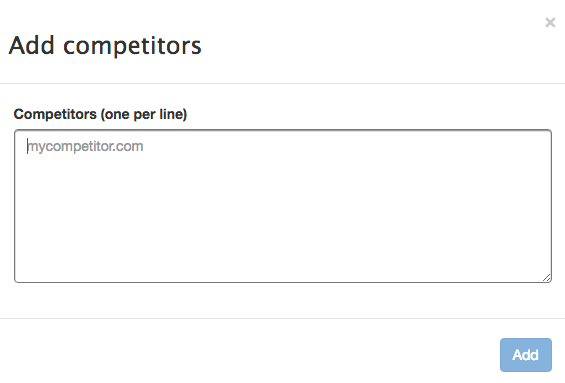
Common mistakes in the generation of topical content that can negatively influence your positioning
- Publish the news when the peak of searches on a particular term has already passed.
- Be one of the last media to publish the news.
- Do not update the part frequently.
- Updating the content of the piece without adapting the title to the user’s new search intent.
- Related content outweighs the main content.
- Do not link to the news item from a prominent place on the website.
And you, what strategy do you follow to make your news content gain visibility over the rest of the news published by your competitors’ media?
